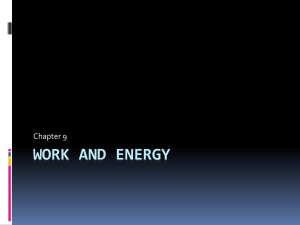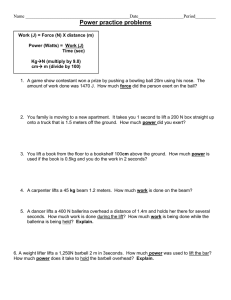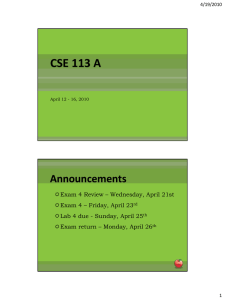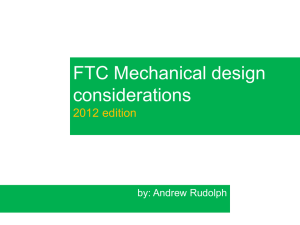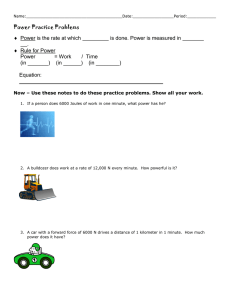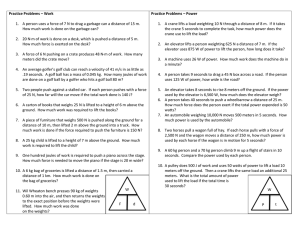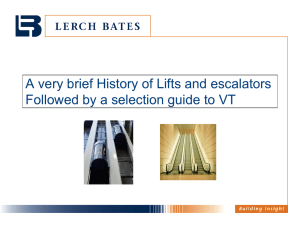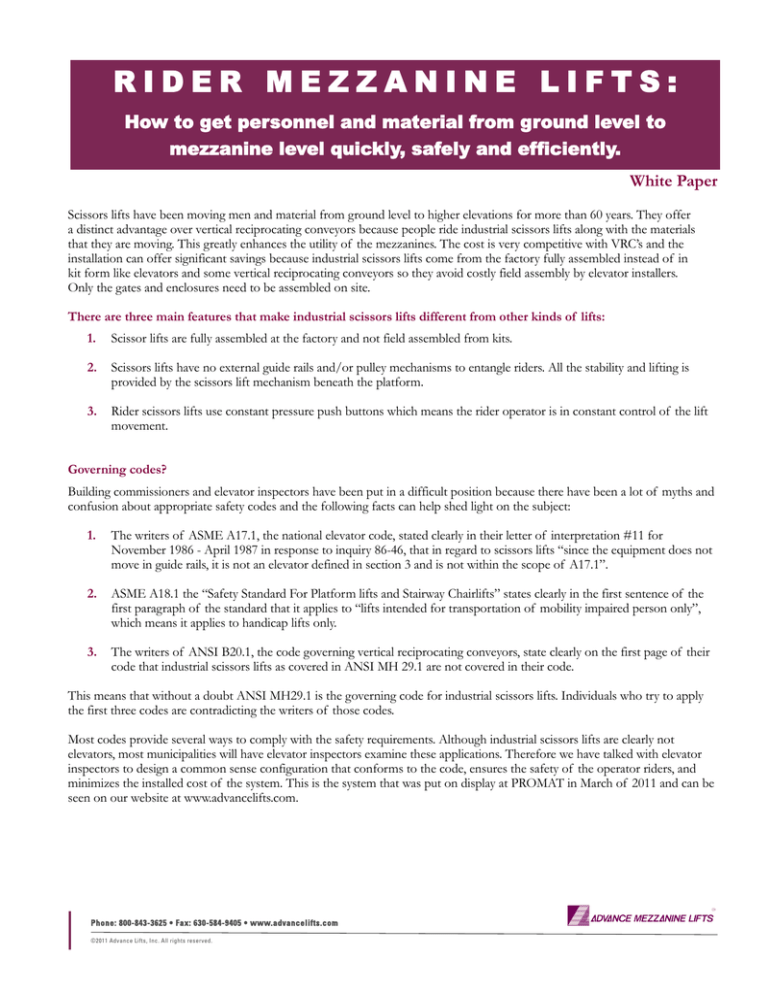
RIDER MEZZANINE LIFTS:
How to get personnel and material from ground level to
mezzanine level quickly, safely and efficiently.
White Paper
Scissors lifts have been moving men and material from ground level to higher elevations for more than 60 years. They offer
a distinct advantage over vertical reciprocating conveyors because people ride industrial scissors lifts along with the materials
that they are moving. This greatly enhances the utility of the mezzanines. The cost is very competitive with VRC’s and the
installation can offer significant savings because industrial scissors lifts come from the factory fully assembled instead of in
kit form like elevators and some vertical reciprocating conveyors so they avoid costly field assembly by elevator installers.
Only the gates and enclosures need to be assembled on site.
There are three main features that make industrial scissors lifts different from other kinds of lifts:
1.
Scissor lifts are fully assembled at the factory and not field assembled from kits.
2.
Scissors lifts have no external guide rails and/or pulley mechanisms to entangle riders. All the stability and lifting is
provided by the scissors lift mechanism beneath the platform.
3.
Rider scissors lifts use constant pressure push buttons which means the rider operator is in constant control of the lift
movement.
Governing codes?
Building commissioners and elevator inspectors have been put in a difficult position because there have been a lot of myths and
confusion about appropriate safety codes and the following facts can help shed light on the subject:
1.
The writers of ASME A17.1, the national elevator code, stated clearly in their letter of interpretation #11 for
November 1986 - April 1987 in response to inquiry 86-46, that in regard to scissors lifts “since the equipment does not
move in guide rails, it is not an elevator defined in section 3 and is not within the scope of A17.1”.
2.
ASME A18.1 the “Safety Standard For Platform lifts and Stairway Chairlifts” states clearly in the first sentence of the
first paragraph of the standard that it applies to “lifts intended for transportation of mobility impaired person only”,
which means it applies to handicap lifts only.
3.
The writers of ANSI B20.1, the code governing vertical reciprocating conveyors, state clearly on the first page of their
code that industrial scissors lifts as covered in ANSI MH 29.1 are not covered in their code.
This means that without a doubt ANSI MH29.1 is the governing code for industrial scissors lifts. Individuals who try to apply
the first three codes are contradicting the writers of those codes.
Most codes provide several ways to comply with the safety requirements. Although industrial scissors lifts are clearly not
elevators, most municipalities will have elevator inspectors examine these applications. Therefore we have talked with elevator
inspectors to design a common sense configuration that conforms to the code, ensures the safety of the operator riders, and
minimizes the installed cost of the system. This is the system that was put on display at PROMAT in March of 2011 and can be
seen on our website at www.advancelifts.com.
Phone: 800-843-3625 • Fax: 630-584-9405 • www.advancelifts.com
©2011 Advance Lifts, Inc. All rights reserved.
The essential ingredients of a proper mezzanine lift are as follows:
1.
A properly configured industrial scissor lift. The platform should be equipped with bevel toe guards and 42” high
guardrails with mid rails and 4” toe plates. The lift platform should have electrically interlocked gates that prevent lift
movement unless the lift gates are closed. The interlocked gates are not required by code, but will be a common sense
addition required by most municipalities and/or elevator inspectors. The unit should have proximity switches or limit
switches for each level. The control shall be a constant pressure pushbutton that the rider operator must keep
depressed to maintain movement of the lift (the use of call/send buttons are not allowed with riders on the lift).
The lift should also be equipped with an emergency down valve on the power unit to lower the lift in case of power
failure. Again this is not a code requirement, but most municipalities or inspectors will require it.
2.
A smooth mezzanine fascia. The entire surface of the mezzanine adjacent to the lift from ground level to the top
of the guardrail on the upper level must be equipped with a smooth face to eliminate shear points. This may be
wallboard, polycarbonate GP sheets or fine mesh. Interlocked doors & windows are allowed.
3.
An enclosure system. The sides not adjacent to the mezzanine must be enclosed from ground level to the height of the
highest guardrail in the fully raised position. The guardrail on the mezzanine and the access gates on the enclosure must
be electrically interlocked to prevent lift movement when the gates or doors are opened and mechanically locked so that
they can not be opened unless the lift platform is present. The gap between the platform and the mezzanine should be
1”. The gap between the platform and the enclosure on all other sides should be approximately 3” to 4”. This gap
requirement is not by code, but another common sense requirement required by most inspectors.
The configuration should look like this:
Note that Advance lifts will always supply a configuration drawing after receipt of order so that users and inspecting authorities
can make comments before the equipment is built and shipped.
What about inspections of these lifts?
We studied elevator inspection forms from several states and realized that the forms closely followed the underlying elevator
code. So we developed an inspection form following the same reasoning based on the latest draft of ANSI MH29.1 which is
in the final stages of the revision process and should be released by this summer. This form was then reviewed by elevator
inspectors and further refined into its current form which we call the “Inspection Checklist For Industrial Scissors Lifts At
Mezzanines” form AL-2010 Rev 1. This should be a big help to elevator inspectors and municipal building
commissioners around the country. The forms are available on our website, advancelifts.com.
Some people have referred to our mezzanine lifts as dock lifts on steroids. As the leading dock lift manufacturer in the country
since 1974, it is only natural that we have taken the lead in developing this product. If you would like further information please
visit our website www.advancelifts.com or call us at 800-843-3625. We would be happy to share our knowledge with you.
Henry J. Renken
President
Advance Lifts, Inc.
Phone: 800-843-3625 • Fax: 630-584-9405 • www.advancelifts.com
©2011 Advance Lifts, Inc. All rights reserved.

